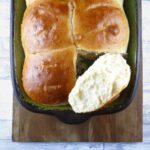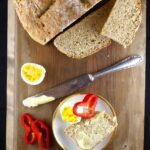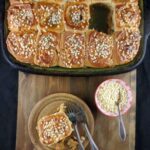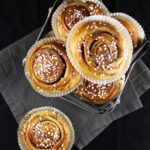Soft Spelt Flour Hot Dog Buns
These super soft spelt flour hot dog buns are so easy to make, and once you’ve tried how delicious they are, you will never buy them in again. The buns can be made with plain (all-purpose) or spelt flour, and the instructions include preparing the dough in either a stand mixer or bread maker.
These simple, yet oh so soft, spelt flour hot dog buns are amazing. Quick, no fancy ingredients, just bread that is unbelievably soft.
Unless you’ve been sleeping under a rock, you know most hot dogs are not healthy. However, if you live in Sweden, you can’t escape the good old sausage. They are everywhere. And my kids have always loved a good ‘dog. White, mass-produced hot dog bread is a no-go though. Not in my house, anyway.
So why not make your kids’ day and whip up some good old hot dogs, just a little healthier, thanks to these spelt flour hot dog buns. Goodness, if you add fried onions and ketchup, you are well on your way to having your five a day. Just kidding.
And did you know, you can use the exact dough recipe to make sweet iced fingers, a bakery favourite across the UK? Yep, you can. Here is my recipe for beautiful blackberry iced finger buns to prove it.
Is a bread machine worth it?
Yes, I think so.
It’s all about personal preference, though. I know many people who make beautiful bread without the need of a bread machine. In fact, they don’t even own a stand mixer. For me, the biggest perk is a bread maker’s reliability, and by that I mean, it does what it’s supposed to. This means that you can predict the end result quite accurately. With just a push of a button, modern bread machines, with their digital controls and timers, means you can add the ingredients to the machine and let it work its magic. As much as I enjoy the simplicity of my stand mixer, one of the drawbacks is that I need to keep a fairly close eye on what the dough is doing, which isn’t the case with a bread machine.
One negative of a bread machine is that it has limited uses. Although modern bread machines often have options to bake cakes or even make jam, I’ve personally never used mine for anything other than baking bread. In fact, in the past, my bread machine was used to just prepare dough. I wasn’t overly fond of the end result of my loaves. That was until I realised that spelt flour doesn’t behave the same as other flour in a bread machine. I carried out extensive research (okay, baked a ton of bread loaves and ate them), as to why this happened. Have a read of my Wholegrain spelt: which bread machine cycle is best.
What are the benefits of making your own bread?
I am fully aware that a hot dog is the kind of food you eat as a quick snack or light lunch. I therefore understand why you don’t have neither the time nor the inclination to make bread from scratch. But, hands down, it’s so much better for you. And if you have ever had the pleasure of the wafting scent of baking bread, you will understand the appeal of fresh bread. There is nothing, nothing that beats the smell of fresh bread. It’s no surprise that estate agents (realtors) advise baking a loaf before any prospective buyers show up. Warm bread, slathered in butter, is other worldly. If you add seeds, and a touch of wholemeal flour, you will never buy bread again.
The problem is that many of us have got so used to processed white bread that we find the denser crumb of some home-baked loaves off-putting. I’ve got to be honest and say that when I used to eat meat, a bacon sandwich had to be on the softest white bread imaginable, and there’s nothing softer that bread made in a factory. But what if I told you that these hot dog buns are just as soft as any shop-bought bun you might find? Look at the crumb on them. Does it look dense to you? No, siree.
Taste aside, I personally like to know what’s in my food. And that’s not me getting all holier than thou. I don’t preach, but I do like to make informed choices. One of the reasons I switched to spelt flour (and making my own bread) was that store bought bread really hurt my stomach. I’ve been sensitive to gluten for as long as I remember and had my gall-bladder removed nearly 20 years ago. Every now and again, I do have factory produced bread and I really suffer the consequences.
Factory bread: The fermentation process
A huge downside of store-bought bread is how quickly it is made. Factories are now equipped with impressive production lines and often use something called the Chorleywood Baking Process. This allows for the manufacturing of bread on a grand scale. Traditionally, making bread was a lengthy process, with time given to allow for a slow proofing. Being able to radically accelerate this time-consuming step of making bread has not only altered how it is made, but seemingly, the effect it has on our bodies.
One of the reasons why I switched to making my own bread was that my digestive system couldn’t handle mass-produced factory loaves. At first I thought it was the gluten, but it appears that the culprit might actually be the faster proofing process.
A little chemistry: fermentation in bread takes place when yeast begins to feed on the sugar found in the dough. This kicks off the production of carbon dioxide and alcohol. The carbon dioxide gets trapped in the dough, causing little pockets of air to form, and this is what causes the bread rise. Now, imagine this process speeded up? I am no scientist, and this is a baking blog, but before I get back in my lane, it’s worth considering the possible implications of eating bread that has been artificially enhanced.
Additives in store bought bread
It’s not only the fermentation process that sets alarm bells ringing when talking about mass-produced bread. We can’t throw all bread into the same basket, as there are some beautifully nutritious breads available. However, your regular white sliced loaf is packed with additives and ingredients that you really don’t want in your bread.
Ever left a shop-bought loaf on the counter for days (if not weeks) only to realise it never got moldy? I have. Messing around one day, I hit one of my teenagers with a loaf of sliced bread. Don’t ask. The packaging burst open and bread catapulted in every direction. Unbeknown to me, one slice had landed on top of the kitchen cupboards. Months later, I found it. It was as good as the day I’d accidentally flung it up there. Yep, that will be the preservatives. Other unwelcome additions include salt, unhealthy vegetable fat, and sweeteners (such as corn syrup or dextrose).
Simple homemade spelt bread recipes
I have made spelt bread in all shapes, flavours and sizes. Here are some of my favourite simple spelt recipes:
- Cheddar cheese and garlic spelt bread
- Wholegrain spelt oat buns
- Wholemeal cinnamon loaf bread
- Spelt garlic butter naan bread
- Mozzarella and red onion bread
- Monterey Pepper Jack spelt focaccia
- Spelt subway buns
Super Soft Spelt Flour Hot Dog Buns
Ingredients
- 1 egg (medium)
- 250ml (1 cup) milk
- 50g (3½ tbs) butter (sliced into small pieces)
- 450-480g (3¾ - 4 cups) spelt flour (see note 2)
- 7g (2¼ tsp) dried yeast (see note 3)
- ½ tbs sugar
- 1 tsp salt
Instructions
DOUGH (see note 1)
Bread Machine:
- Add the egg, milk, and butter to your bread machine pan. Then add 450g (3¾ cups) flour and the remaining dry ingredients. Set your machine to make dough.
- When ready, pour the dough out onto a very well-floured surface.
- Work in extra flour (if necessary) until you have a soft, pliable, but still a little tacky, dough. Form into a rough ball.
Stand Mixer:
- Add the milk, egg, and butter to your stand mixer bowl, and mix together. If the butter is straight out of the fridge, it won't combine with the other wet ingredients too much, but that's okay.
- Then add 450g (3¾ cups) of flour, and the remaining ingredients. If you need more flour, just add it a little at a time.
- The dough should be sticky, but if you need more flour, just add a little at a time. Be careful: too much flour will result in dry bread.
- Switch to a dough hook (if you have one) and allow the mixer to knead the dough for around 10 minutes, just until soft. The dough will still feel a little tacky to the touch, but will be able to slowly drop off the hook.
- Cover the dough and leave to proof (until it has doubled in size - usually about an hour).
- When the dough is ready, knock it back, and on a floured surface, form into a rough ball.
Both methods:
- Pre-heat the oven to 200°C (400℉).
- Divide the dough into 8 pieces of around the same weight.
- Roll each piece into a "hot dog roll" shape of around 14cm long. Fold the edges into the middle all the way around and pinch to seal the seams.
- Place the rolls, seam side down, on a large baking tray lined with grease proof paper. I like to position my buns close together so that they merge, as this creates softer buns. To do this, they need a space of only 1-2cm between them. If you would prefer the buns to not spread into each other, make sure you have more space between them.
- Cover with a tea towel and leave in a warm place for around 30 minutes.
- Bake for 10 minutes, in a lower part of the oven, just until the tops are nice and brown. Remove from the oven and allow to cool completely before stuffing with your favourite sausage. Enjoy!
Notes
- I have made the dough using both a stand mixer and bread machine with identical results. I have not made the dough by hand, but I see no reason why you couldn't do so!
- You can use spelt or regular flour for this recipe (just use the same amount).
- In Sweden we have something called dried yeast. It is used both in warm liquid to proof and also added directly to flour. I am aware that the US has two options for dried yeast, and I believe instant yeast is the most similar to our dried yeast.









6 thoughts on “Soft Spelt Flour Hot Dog Buns”